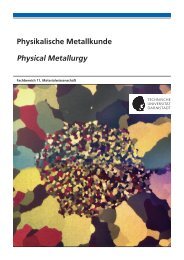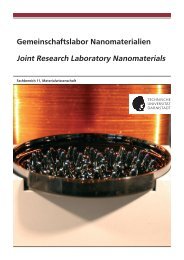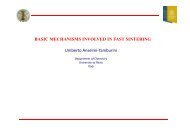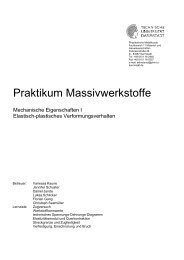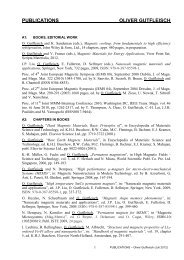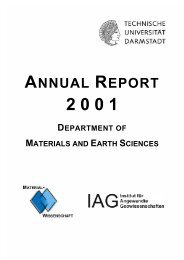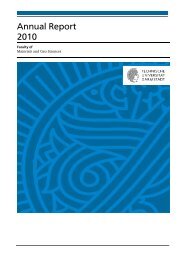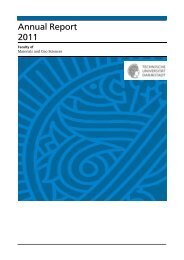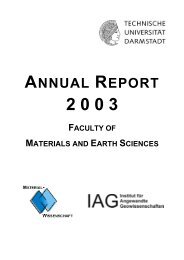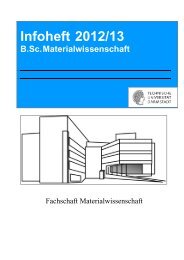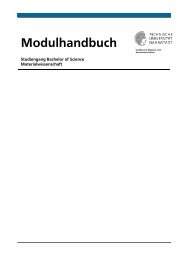Effect of heating rate
Effect of heating rate
Effect of heating rate
You also want an ePaper? Increase the reach of your titles
YUMPU automatically turns print PDFs into web optimized ePapers that Google loves.
Mechanisms during FAST 4:<br />
Oxide ceramics<br />
Olivier Guillon<br />
March 24, 2011 | FAST School | O. Guillon | 1
Outline<br />
Lower temperatures, higher densities, smaller grain sizes<br />
…compared to free sintering!<br />
Question: What really happens during FAST?<br />
Methodology to answer this question:<br />
� FAST vs. Hot Pressing<br />
• Identification <strong>of</strong> main densification mechanism<br />
• Evaluation <strong>of</strong> microstructure<br />
� <strong>Effect</strong> <strong>of</strong> <strong>heating</strong> <strong>rate</strong><br />
� <strong>Effect</strong> <strong>of</strong> electric field/current<br />
March 24, 2011 | FAST School | O. Guillon | 2
Goal<br />
� Transition from the „black box“ era to the intelligent „tool box“ approach<br />
?<br />
� When you know how a tool works, you can get more out <strong>of</strong> it!<br />
� Based on experimental evidence<br />
March 24, 2011 | FAST School | O. Guillon | 3<br />
!
FAST vs. Hot Pressing<br />
� FAST (HP 25/1, FCT Systeme)<br />
Measuring system:<br />
• Pyrometer (P) from 450°C (standard)<br />
• Thermocouple (T) from<br />
room temperature (optional)<br />
� HP (HPW 150, FCT Systeme)<br />
Measuring system:<br />
• Thermocouple (T)<br />
Temperature calibration<br />
By melting copper powder<br />
March 24, 2011 | FAST School | O. Guillon | 4<br />
(T)<br />
(P)<br />
FAST<br />
Sample<br />
Graphite<br />
felt<br />
HP<br />
(T)
a - alumina (Al 2O 3)<br />
� Insulator (dielectric)<br />
� Model material for sintering studies<br />
Purity: 99.99 %<br />
Average particle size: 150 nm<br />
(TMDAR, Taimei Chem., JP)<br />
Purity: 99.80 %<br />
Average particle size: 700 nm<br />
(CT 3000 SG, ALMATIS, USA)<br />
Theoretical density: 3.986 gcm -3<br />
J. Langer, M. H<strong>of</strong>fmann, O. Guillon, Acta Materialia (2009)<br />
March 24, 2011 | FAST School | O. Guillon | 5<br />
Powder filling<br />
Ø 20mm pressing tool<br />
Initial compaction<br />
(50 MPa, 3 min)<br />
Load adjustment<br />
15-50 MPa<br />
Start <strong>of</strong> the sintering experiments<br />
Heating <strong>rate</strong>: 10 Kmin -1<br />
Max. temperature: 1100-1250 °C<br />
Atmosphere: Vacuum<br />
Dwell time: up to 2 h
Relative density<br />
Sintering behavior <strong>of</strong> alumina<br />
Time<br />
� Curves for FAST and HP show similar trends, for both particle sizes<br />
� Densification starts earlier for FAST but same final densities<br />
� Differences in relative density at the beginning <strong>of</strong> dwell time:<br />
150 nm: Dr rel = 0.076 DT ≈ 25 K<br />
700 nm: Dr rel = 0.026 DT ≈ 05 K<br />
March 24, 2011 | FAST School | O. Guillon | 6<br />
Relative density<br />
Dwell time Dwell time<br />
Time
Analysis <strong>of</strong> the sintering mechanism<br />
True strain:<br />
�<br />
d�<br />
dt<br />
z<br />
�<br />
� z<br />
r<br />
� h �<br />
� ln � �<br />
� �<br />
� h0<br />
�<br />
dr<br />
dt<br />
r = relative density p a = applied pressure<br />
H = numerical constant T = temperature<br />
f = stress intensification factor * G = grain size<br />
n = stress exponent m = grain size exponent<br />
G<br />
HD<br />
March 24, 2011 | FAST School | O. Guillon | 7<br />
1<br />
�<br />
m<br />
kT<br />
* after Montes et al., Comp. Mat. Sci. (2006)<br />
ρ 0 green density<br />
or Helle et al., Acta Metall. (1985)<br />
� � n<br />
fp<br />
a<br />
� � 1 � r ��<br />
f � �1<br />
� � �<br />
� �<br />
�<br />
1<br />
�<br />
� � r 0 ��<br />
f �<br />
r ²<br />
1 � r<br />
0<br />
�r � r �<br />
0<br />
�1<br />
Mechanism Stress<br />
exp. n<br />
Grain size<br />
exp. m<br />
Lattice diffusion 1 2<br />
Grain boundary<br />
diffusion<br />
1 3<br />
Viscous flow 1 0<br />
Grain boundary<br />
sliding<br />
Plastic<br />
deformation<br />
1 or 2 1<br />
≥3 0<br />
M.N. Rahaman, Ceramic Processing and Sintering (2003)
Grain size measurement<br />
h<br />
Sample cross-section<br />
Grain size analysis<br />
(linear intercept method on<br />
SEM micrographs)<br />
March 24, 2011 | FAST School | O. Guillon | 8<br />
Homogeneous grain size<br />
in the whole sample for all<br />
investigated densities
Grain size measurement<br />
March 24, 2011 | FAST School | O. Guillon | 9<br />
R. Zuo, E. Aulbach, J. Rödel<br />
Acta Mater. (2003)<br />
� Marked grain growth from ρ rel > 0.95<br />
� Identical sintering trajectories for FAST and HP<br />
� Reduced grain growth in comparison to free sintering
Analysis <strong>of</strong> the sintering mechanism<br />
Relative density<br />
1 dr<br />
� �<br />
r dt<br />
Time<br />
HD<br />
kT<br />
�<br />
� �<br />
�<br />
r = relative density p a = applied pressure<br />
H = numerical constant T = temperature<br />
f = stress intensification factor * G = grain size<br />
n = stress exponent m = grain size exponent<br />
G<br />
March 24, 2011 | FAST School | O. Guillon | 10<br />
1<br />
m<br />
Dwell time<br />
�<br />
�<br />
�<br />
�<br />
� � n<br />
fp<br />
a<br />
T & G<br />
const.<br />
T & (fp a)<br />
const.
Analysis <strong>of</strong> the sintering mechanism<br />
Relative density<br />
1 dr<br />
� �<br />
r dt<br />
Time<br />
HD<br />
kT<br />
�<br />
� �<br />
�<br />
r = relative density p a = applied pressure<br />
H = numerical constant T = temperature<br />
f = stress intensification factor * G = grain size<br />
n = stress exponent m = grain size exponent<br />
G<br />
March 24, 2011 | FAST School | O. Guillon | 11<br />
1<br />
m<br />
Dwell time<br />
�<br />
�<br />
�<br />
�<br />
� � n<br />
fp<br />
a<br />
T & G<br />
const.<br />
T & (fp a)<br />
const.<br />
n ≈ 1<br />
for FAST and HP<br />
Densification is controlled<br />
by grain boundary<br />
diffusion<br />
m ≈ 3<br />
for FAST and HP
Relative density<br />
Calculation <strong>of</strong> the activation energy<br />
Time<br />
D � D � e 0<br />
� Q<br />
� �<br />
� RT<br />
D 0 = diffusion coefficient T = absolute temperature<br />
D 0 = pre-exponential factor R = gas constant<br />
Q = activation energy<br />
March 24, 2011 | FAST School | O. Guillon | 12<br />
Dwell time<br />
�<br />
�<br />
�<br />
Similar value for the activation energy:<br />
Grain boundary diffusion<br />
HP Q = 430 ± 50 kJ/mol<br />
FAST Q = 420 ± 35 kJ/mol<br />
Wang & Raj,<br />
J. Am. Ceram. Soc. (1990)<br />
Q = 440 ± 45 kJ/mol
Results for other materials<br />
Comparative studies FAST / HP:<br />
� Cubic zirconia (8YSZ), ionic conductor: same densification mechanism and<br />
sintering trajectory<br />
� Zinc oxide (ZnO), semi-conductor: same densification mechanism (grain size very<br />
sensitive to temperature variations)<br />
� Tetragonal zirconia (TZ3Y): same densification mechanism and sintering<br />
trajectory<br />
� AlCuFeB quasi-crystals: same densification mechanism<br />
March 24, 2011 | FAST School | O. Guillon | 13<br />
J. Langer, M. H<strong>of</strong>fmann, O. Guillon, J. Am. Ceram. Soc. (2011)<br />
J. Langer, M. H<strong>of</strong>fmann, O. Guillon, J. Am. Ceram. Soc. (2011)<br />
G. Bernard-Granger, A. Addad, G. Fantozzi, G. Bonnefont, C. Guizard, D. Vernat, Acta Mater. (2010)<br />
L. Ramond, G. Bernard-Granger, A. Addad, C. Guizard, Acta Mater (2010)
Results for other materials<br />
March 24, 2011 | FAST School | O. Guillon | 14<br />
with grain size<br />
MgAl 2O 4 spinel<br />
SPS<br />
Similar mechanisms as for hot pressing<br />
� Low stress regime: diffusion<br />
� High stress regime: climb-controlled dislocation creep<br />
K. Morita, B.N. Kim, H. Yoshida, K. Hiraga,<br />
Scripta Mater. (2010)<br />
Densification maps for MgO<br />
R. Chaim, M. Margulis<br />
Mat.Sci. Eng. A (2005)
Investigation <strong>of</strong> the initial sintering stage<br />
� Thermal conductivity proportional to the contact area between particles<br />
� Same values for HP und FAST samples above 65% density<br />
� <strong>Effect</strong> <strong>of</strong> the temperature overshoot at the beginning <strong>of</strong> the FAST process?<br />
March 24, 2011 | FAST School | O. Guillon | 15<br />
Thermal conductivity<br />
Alumina<br />
Relative density<br />
Laser Flash<br />
measurements<br />
J. Langer, M. H<strong>of</strong>fmann, O. Guillon,<br />
Acta Materialia (2009)
Temperature pr<strong>of</strong>ile during FAST process<br />
March 24, 2011 | FAST School | O. Guillon | 16<br />
� Over<strong>heating</strong> up to 130 °C at the<br />
beginning <strong>of</strong> the <strong>heating</strong> process<br />
(pyrometer control only above ~400°C;<br />
input power fixed)<br />
� <strong>Effect</strong>s on neck formation and neck<br />
growth (especially for nano-powders)
<strong>Effect</strong> <strong>of</strong> the pressing tool and<br />
temperature control<br />
FAST Thermocouple:<br />
without overshoot<br />
Density difference depends on:<br />
• the pressing tool used<br />
• the temperature control<br />
March 24, 2011 | FAST School | O. Guillon | 17<br />
Relative Density, r rel<br />
1.00<br />
0.95<br />
0.90<br />
0.85<br />
0.80<br />
0.75<br />
0.70<br />
0.65<br />
0.60<br />
0.55<br />
0.50<br />
TMDAR<br />
50 MPa<br />
Alumina<br />
1) FAST Pyrometer<br />
2) FAST Thermocouple<br />
3) HP Thermocouple<br />
4) HP FAST-Tool<br />
0 1 2 3 4 5 6 7 8<br />
Time, 10 3 *t [sec]<br />
Begin <strong>of</strong><br />
Dwell Time<br />
T max = 1200 °C
<strong>Effect</strong> <strong>of</strong> temperature control<br />
Relative Density, r rel<br />
1.00<br />
0.95<br />
0.90<br />
0.85<br />
0.80<br />
0.75<br />
0.70<br />
0.65<br />
0.60<br />
0.55<br />
0.50<br />
0.45<br />
(a)<br />
Starting point<br />
Dwell time<br />
NG20<br />
750 °C<br />
50 MPa<br />
FAST<br />
HP<br />
0 1 2 3 4<br />
Time, 10 3 *t [sec]<br />
Dramatic effect <strong>of</strong> transient over<strong>heating</strong> on densification kinetics<br />
for sensitive materials like ZnO (20 nm particle size)<br />
(b)<br />
NG20<br />
550 °C<br />
50 MPa<br />
Starting point<br />
Dwell time<br />
FAST Pyro<br />
FAST Thermo<br />
HP<br />
0.0 0.5 1.0 1.5<br />
J. Langer, M. H<strong>of</strong>fmann, O. Guillon, J. Am. Ceram. Soc. (2011)
Resistivity, r el [�cm]<br />
Consequences on properties<br />
2x10 3<br />
10 3<br />
FAST r rel = 0.74<br />
HP r rel = 0.75<br />
NA90<br />
50 MPa / 750 °C<br />
ZnO 90 nm<br />
400 450 500 550 600 650 700 750<br />
Temperature, T [°C]<br />
� Slightly lower resistivity for FAST samples, but same order <strong>of</strong> magnitude<br />
� Correlates with the larger interparticle contact area shown by<br />
Young‘s modulus measurements (due to initial temperature overshoot)
Outline<br />
Lower temperatures, higher densities, smaller grain sizes<br />
…compared to free sintering!<br />
Question: What really happens during FAST?<br />
Methodology to answer this question:<br />
� FAST vs. Hot Pressing<br />
• Identification <strong>of</strong> main densification mechanism<br />
• Evaluation <strong>of</strong> microstructure<br />
� <strong>Effect</strong> <strong>of</strong> <strong>heating</strong> <strong>rate</strong><br />
� <strong>Effect</strong> <strong>of</strong> electric field/current<br />
March 24, 2011 | FAST School | O. Guillon | 20
<strong>Effect</strong> <strong>of</strong> <strong>heating</strong> <strong>rate</strong>: alumina<br />
Relative Density<br />
1.0<br />
0.9<br />
0.8<br />
0.7<br />
0.6<br />
0.5<br />
March 24, 2011 | FAST School | O. Guillon | 21<br />
35 K/min<br />
50 K/min<br />
100 K/min<br />
150 K/min<br />
-800 -600 -400 -200 0 200 400 600<br />
Time (s)<br />
1200°C<br />
Isothermal step<br />
� Same final density is reached<br />
� Is there a change in the densification mechanism?<br />
O. Guillon & J. Langer,<br />
J Mater Sci, 2010
<strong>Effect</strong> <strong>of</strong> <strong>heating</strong> <strong>rate</strong>: alumina<br />
Heating <strong>rate</strong><br />
[K/min]<br />
Slope<br />
[10 -3 K -1 ]<br />
10 1.7 ± 0.2<br />
35 1.6 ± 0.2<br />
50 1.7 ± 0.2<br />
100 1.5 ± 0.2<br />
150 1.4 ± 0.3<br />
� Slope independent <strong>of</strong> the <strong>heating</strong> <strong>rate</strong><br />
� Same results for 8YSZ<br />
March 24, 2011 | FAST School | O. Guillon | 22
Master Sintering Curve approach<br />
Free sintering:<br />
FAST/HP:<br />
dr 3��<br />
� � D � D<br />
V V b b<br />
� � �<br />
3<br />
4<br />
rdt<br />
kT � G G<br />
� ( t,<br />
T ( t))<br />
1 dr<br />
�<br />
r dt<br />
HD<br />
March 24, 2011 | FAST School | O. Guillon | 23<br />
k<br />
p<br />
n<br />
�<br />
G<br />
r<br />
�<br />
0 a r 0<br />
r<br />
t 1 Q k G<br />
� exp � �dt<br />
�<br />
0<br />
�<br />
T RT ��<br />
D 3r<br />
�<br />
HD<br />
m<br />
G<br />
rf<br />
kT<br />
m<br />
n<br />
� �<br />
�<br />
� � n<br />
fp<br />
a<br />
1<br />
dr<br />
� � T<br />
t<br />
0<br />
�<br />
�<br />
exp<br />
�<br />
�<br />
�<br />
�<br />
� �<br />
�<br />
with<br />
0<br />
Q<br />
RT<br />
r<br />
0<br />
rHD<br />
D � D exp<br />
kG<br />
�<br />
�dt<br />
�<br />
( r )<br />
0<br />
( r )<br />
m<br />
p<br />
n<br />
a<br />
m<br />
f<br />
n<br />
0<br />
dr<br />
� � ( t,<br />
T )<br />
� � Q<br />
�<br />
� RT<br />
T<br />
�<br />
�<br />
�<br />
1<br />
� exp<br />
A unique MSC ρ=f(Θ) can be obtained if:<br />
• only one diffusion mechanism is dominant during sintering<br />
• the microstructure is function only <strong>of</strong> density<br />
Su &Johnson, J Am Ceram Soc (1996)<br />
�<br />
� �<br />
�<br />
Q<br />
RT<br />
�<br />
�dt<br />
�
Relative Density<br />
MSC: alumina<br />
1.0<br />
0.9<br />
0.8<br />
0.7<br />
0.6<br />
0.5<br />
-16 -15 -14 -13 -12 -11 -10<br />
Log(�)<br />
March 24, 2011 | FAST School | O. Guillon | 24<br />
Residual sum <strong>of</strong> squares<br />
0.50<br />
0.45<br />
0.40<br />
0.35<br />
0.30<br />
0.25<br />
0.20<br />
0.15<br />
0.10<br />
200 250 300 350 400 450 500<br />
Activation energy (kJ/mol)<br />
� Master Sintering Curve obtained for the whole sintering cycle<br />
� Apparent activation energy <strong>of</strong> 290 kJ/mol<br />
� No change in the densification behavior
Activation energy values<br />
Dry pressing<br />
Pressure filtration<br />
March 24, 2011 | FAST School | O. Guillon | 25<br />
Free sintering <strong>of</strong> alumina (same powder)<br />
Literature: Q = 400-1100 kJ/mol (!)<br />
Dry pressing: 700 � 20 kJ/mol<br />
Pressure filtration: 605 � 15 kJ/mol<br />
� Interplay between different diffusion mechanisms<br />
when whole sintering curve taken into account<br />
� In the density range 70-85%:<br />
450 kJ/mol for both sample types<br />
M. Aminzare, F. Golestani-fard, O. Guillon, M. Mazaheri, H.R. Rezaie,<br />
Materials Science & Engineering A, 2010
High(er) <strong>heating</strong> <strong>rate</strong>s<br />
� Exothermic reaction to produce heat (SHS)<br />
� Applied pressure: 60-120 MPa<br />
� Heating <strong>rate</strong> <strong>of</strong> 1600°C/min<br />
F. Meng, Z. Fu, J. Zhang, H. Wang, W. Wang, Y. Wang, Q. Zhang,<br />
J Am Ceram Soc (2007)<br />
March 24, 2011 | FAST School | O. Guillon | 26<br />
Dense alumina (99%)<br />
in a few minutes
High(er) <strong>heating</strong> <strong>rate</strong>s<br />
J. Zhang, F. Meng, R. Todd, Z. Fu, Scripta Mater. (2010)<br />
Same grain size and density, but different resistance to mechanical abrasion<br />
March 24, 2011 | FAST School | O. Guillon | 27<br />
(1)<br />
(3)
High(er) <strong>heating</strong> <strong>rate</strong>s<br />
(1)<br />
(4)<br />
As-sintered<br />
Annealed at 1500°C<br />
March 24, 2011 | FAST School | O. Guillon | 28<br />
Grain boundaries in non-equilibrium:<br />
� Diffuse, open structure as opposed to<br />
relaxed boundaries?<br />
� Higher diffusion coefficient and thicker<br />
GB?<br />
Also to be seen in other materials?
High <strong>heating</strong> <strong>rate</strong>s: ZnO<br />
March 24, 2011 | FAST School | O. Guillon | 29<br />
20 nm particles<br />
50 MPa<br />
Higher <strong>heating</strong> <strong>rate</strong>s improve sinterability<br />
S. Schwarz, O. Guillon
High <strong>heating</strong> <strong>rate</strong>s: ZnO<br />
50°C/min (ρ= 67%)<br />
100°C/min (ρ= 76%)<br />
Curved GB<br />
Faceted GB<br />
March 24, 2011 | FAST School | O. Guillon | 30<br />
S. Schwarz, A. Thron, K. van Benthem, O. Guillon
Outline<br />
Lower temperatures, higher densities, smaller grain sizes<br />
…compared to free sintering!<br />
Question: What really happens during FAST?<br />
Methodology to answer this question:<br />
� FAST vs. Hot Pressing<br />
• Identification <strong>of</strong> main densification mechanism<br />
• Evaluation <strong>of</strong> microstructure<br />
� <strong>Effect</strong> <strong>of</strong> <strong>heating</strong> <strong>rate</strong><br />
� <strong>Effect</strong> <strong>of</strong> electric field/current<br />
March 24, 2011 | FAST School | O. Guillon | 31
Carbon contamination?<br />
Secondary Ion Mass Spectroscopy (SIMS)<br />
8YSZ<br />
March 24, 2011 | FAST School | O. Guillon | 32<br />
J. Langer, M. H<strong>of</strong>fmann, O. Guillon,<br />
J. Am. Ceram. Soc. (2011)<br />
h<br />
y<br />
TM<br />
Cross section x<br />
� Carbon hardly diffuses into the specimen (constant C-signal at depth <strong>of</strong> ~2 µm)<br />
� Oxygen vacancies are responsible for specimen darkening<br />
� No influence <strong>of</strong> carbon on electrical conductivity / sintering behavior<br />
TR<br />
S
XPS measurements on pure ZnO<br />
• Identical emission spectra for FAST und HP<br />
• Only ZnO could be detected<br />
• No trace <strong>of</strong> carbon
Resistivity changes in pure ZnO<br />
Sample<br />
Sample resistance<br />
Al 2O 3-felt<br />
T = 750 °C 2.5x10 2 Ω<br />
Graphite tool resistance<br />
T = 750 °C 2.0x10 -3 Ω<br />
Vanmeensel et al. J. Mater Sci. (2008)<br />
Relative density, r rel<br />
1.0<br />
0.9<br />
0.8<br />
0.7<br />
0.6<br />
Relative density<br />
Resistance<br />
NA90<br />
SPS / 750 °C /<br />
50 MPa / 5 min<br />
100 200 300 400 500 600 700<br />
Temperature, T [°C]<br />
Semi-conductor behavior<br />
a)<br />
10 6<br />
10 5<br />
10 4<br />
10 3<br />
Resistance, R [ �]
Electrical boundary conditions<br />
direction <strong>of</strong> current<br />
Al 2O 3-discs<br />
p a<br />
sample<br />
J. Langer, M. H<strong>of</strong>fmann, O. Guillon,<br />
J. Am. Ceram. Soc. (2011)<br />
Relative density, r rel<br />
1.00<br />
0.95<br />
0.90<br />
0.85<br />
0.80<br />
0.75<br />
0.70<br />
0.65<br />
0.60<br />
0.55<br />
(a) Standard<br />
(b) Electrically insulated<br />
FAST<br />
NA90<br />
750 °C<br />
50 MPa<br />
ZnO<br />
0 1000 2000 3000<br />
Starting point<br />
dwell time<br />
750 °C<br />
0 1 2 3<br />
Time, 10 3 *t [sec]<br />
No effect <strong>of</strong> electrical boundary conditions<br />
1.00<br />
0.95<br />
0.90<br />
0.85<br />
0.80<br />
0.75<br />
0.70<br />
0.65<br />
0.60
Sintering trajectory <strong>of</strong> pure ZnO<br />
(electrically insulated)<br />
� No significant effect <strong>of</strong> the electric field / current<br />
� <strong>Effect</strong> <strong>of</strong> the temperature overshoot<br />
Standard FAST<br />
z<br />
(a) r rel = 0.97<br />
z<br />
(b)<br />
x<br />
Insulated FAST<br />
x<br />
2 µm<br />
r rel = 0.97 2 µm
Behavior <strong>of</strong> doped ZnO<br />
Sample resistance:<br />
T = 750 °C ~ 5 Ω<br />
Insulated SPS<br />
Standard SPS<br />
T. Misawa, N. Shikatani, Y. Kawakami, T. Enjoji, Y. Ohtsu, H. Fujita<br />
J Mater Sci (2009)<br />
March 24, 2011 | FAST School | O. Guillon | 37<br />
Magnetic<br />
current<br />
probe<br />
Error due to positioning
Current flow through the sample<br />
I sample/I total<br />
Graphite tool<br />
March 24, 2011 | FAST School | O. Guillon | 38<br />
Resistivity <strong>of</strong> sample material [Ωm]<br />
M. Herrmann, B. Weise, K. Sempf, A. Bales, J. Raethel, I. Schulz<br />
Workshop IFAM Dresden (2006)
Electrically conductive composite materials<br />
Electrical conductivity <strong>of</strong> a composite material depends on:<br />
- volume fraction <strong>of</strong> conductive and insulating phases (incl. porosity)<br />
- temperature<br />
Polder-Van Santen mixture rule:<br />
Similar equation for thermal conductivity<br />
March 24, 2011 | FAST School | O. Guillon | 39<br />
*<br />
*<br />
with<br />
m matrix<br />
p particles<br />
V* m volume fraction <strong>of</strong><br />
matrix phase in a<br />
partially sintered compact<br />
K. Vanmeensel, A. Laptev, O. Van der Biest, J. Vleugels<br />
Acta Mat (2007)
Electrical conductivity<br />
90 vol.% TiN (grey) - ZrO 2 (white)<br />
pores (black)<br />
K. Vanmeensel, A. Laptev, O. Van der Biest, J. Vleugels<br />
J Eur Ceram Soc (2007)<br />
March 24, 2011 | FAST School | O. Guillon | 40<br />
Dense ZrO 2-TiN composites
Percolation threshold<br />
March 24, 2011 | FAST School | O. Guillon | 41<br />
Percolation: a continuous path for current is created<br />
K. Vanmeensel, A. Laptev, O. Van der Biest, J. Vleugels<br />
Acta Mater (2007)
<strong>Effect</strong> on densification<br />
March 24, 2011 | FAST School | O. Guillon | 42<br />
ZrO 2-TiN (60/40)<br />
Transition from insulator to conductor-like behavior during sintering
<strong>Effect</strong> <strong>of</strong> electric field on surface diffusion<br />
� Before densification takes place<br />
� Neck growth kinetics estimated from I-V curves<br />
(without additional Joule <strong>heating</strong>)<br />
� No effect <strong>of</strong> electric field<br />
(limited to 10 V/cm)<br />
� Specific Surface Area measurements confirm this result<br />
(identical with and without electric field)<br />
March 24, 2011 | FAST School | O. Guillon | 43<br />
TZ-3Y @ 1050°C<br />
Sample thickness:<br />
2 mm<br />
M. Cologna, R. Raj<br />
J. Am .Ceram. Soc. (2010)
Flash sintering<br />
TZ-3Y<br />
DC-Field<br />
Proposed explanation:<br />
Joule <strong>heating</strong> at grain boundaries (several hundreds <strong>of</strong> °C)<br />
March 24, 2011 | FAST School | O. Guillon | 44<br />
But why then:<br />
M. Cologna, B. Rahkova, R. Raj<br />
J. Am .Ceram. Soc. (2010)
Relative Density<br />
Flash sintering: an effect <strong>of</strong> current<br />
8YSZ<br />
AC Field<br />
0.90<br />
0.85<br />
0.80<br />
0.75<br />
0.70<br />
0.65<br />
0.60<br />
0.55<br />
0.50<br />
400 600 800 1000<br />
Temperature<br />
March 24, 2011 | FAST School | O. Guillon | 45<br />
0V<br />
40V/cm; max. 0.02 A/cm²<br />
from room temperature<br />
40V/cm; max. ~1.5 A/cm²<br />
40V/cm at 1150°C; max ~6 A/cm²<br />
0.90<br />
0.85<br />
0.80<br />
0.75<br />
0.70<br />
0.65<br />
0.60<br />
0.55<br />
1200 20 40 60 80 100 120 0.50<br />
Isothermal time [min]<br />
Absolute Density [g/cm³ ]<br />
4.75<br />
4.70<br />
4.65<br />
4.60<br />
4.55<br />
4.50<br />
4.45<br />
4.40<br />
4.35<br />
current switch <strong>of</strong>f<br />
induces a<br />
temperature drop<br />
<strong>of</strong> ~ 450 °C<br />
8YSZ flashed at 1150°C with 40V/cm; max. 5A<br />
0 2 4 6 8 10 12 14 16 18<br />
Isothermal time [min]<br />
R. Baraki, S. Schwarz, O. Guillon
Comparison Flash Sintering / FAST<br />
FAST:<br />
� limited voltage, applied from the beginning<br />
� electric equipotential affected by the conducting pressing tool<br />
DV sample<br />
=10 V<br />
ZrO2 (sinter-forging)<br />
Flash sintering conditions are not expected in standard FAST<br />
March 24, 2011 | FAST School | O. Guillon | 46<br />
electrode<br />
DV sample<br />
=2.68 V<br />
ZrO2 (in graphite tool)<br />
S. Schwarz,<br />
O. Guillon
Conclusions<br />
� Identification <strong>of</strong> sintering mechanism requires „clean“ experimental<br />
conditions to avoid misunterpretations<br />
� For „insulating“ oxide ceramics:<br />
• Same densification mechanism for HP and FAST<br />
(not only based on activation energy considerations)<br />
• Identical grain growth behavior<br />
• No effect <strong>of</strong> electrical field during sintering in FAST<br />
� Transient <strong>heating</strong> affects subsequent densification<br />
� Densification behavior may depend on the <strong>heating</strong> <strong>rate</strong> (or not: MSC)<br />
� Large electric current (not field) may lead to additional phenomena<br />
(Flash sintering)<br />
March 24, 2011 | FAST School | O. Guillon | 47



